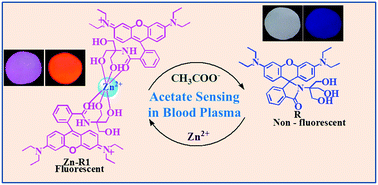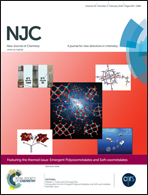A sandwich-type zinc complex from a rhodamine dye based ligand: a potential fluorescent chemosensor for acetate in human blood plasma and a molecular logic gate with INHIBIT function†
Abstract
A new fluorescent zinc complex Zn-R1 based on rhodamine-tris(hydroxymethyl)aminomethane spirolactam ligand R has been synthesised and characterised. Single crystal X-ray diffraction analyses revealed that in this complex R exists in its ring opened spirolactam form R1 and the complex Zn-R1 has a distinctive geometry in which the Zn2+ ion is sandwiched between the dye motifs of two R1 ligands. Zn-R1 exhibits very strong orange fluorescence and pink colour in acetonitrile : H2O (9.5 : 0.5%, v/v) solutions and the addition of acetate ions causes quenching of the fluorescence accompanied by a colour change from pink to colourless. The mode of interaction between Zn-R1 and acetate ions has been confirmed by absorption, fluorescence, NMR and HR-MS techniques. Further, Zn-R1 is highly selective towards acetate ions and exhibits potential as a sensor for acetate in solid state and in solutions including human blood plasma-like systems. The reversibility of acetate binding by Zn-R1 is demonstrated by adding an excess of acetate and Zn2+ ions alternately to the solution of Zn-R1 for multiple times. The fluorescence output shown by Zn-R1 on addition/non-addition of Zn2+ and acetate ions as sequential inputs can be used to construct an INHIBIT type molecular logic gate.


 Please wait while we load your content...
Please wait while we load your content...